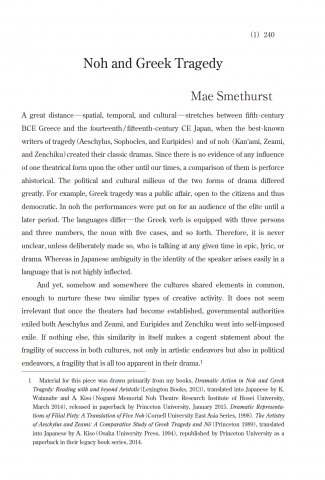
Journal of the Institute of Nogaku Studies 41: pp. 240-230
A great distance―spatial, temporal, and cultural―stretches between fifth - century BCE Greece and the fourteenth/fifteenth-century CE Japan, when the best-known writers of tragedy(Aeschylus, Sophocles, and Euripides)and of noh(Kan’ami, Zeami, and Zenchiku)created their classic dramas. Since there is no evidence of any influence of one theatrical form upon the other until our times, a comparison of them is perforce ahistorical. The political and cultural milieus of the two forms of drama differed greatly. For example, Greek tragedy was a public affair, open to the citizens and thus democratic. In noh the performances were put on for an audience of the elite until a later period. The languages differ―the Greek verb is equipped with three persons and three numbers, the noun with five cases, and so forth. Therefore, it is never unclear, unless deliberately made so, who is talking at any given time in epic, lyric, or drama. Whereas in Japanese ambiguity in the identity of the speaker arises easily in a language that is not highly inflected.
And yet, somehow and somewhere the cultures shared elements in common, enough to nurture these two similar types of creative activity. It does not seem irrelevant that once the theaters had become established, governmental authorities exiled both Aeschylus and Zeami, and Euripides and Zenchiku went into self-imposed exile. If nothing else, this similarity in itself makes a cogent statement about the fragility of success in both cultures, not only in artistic endeavors but also in political endeavors, a fragility that is all too apparent in their drama.
